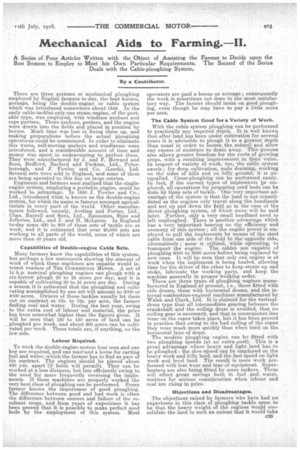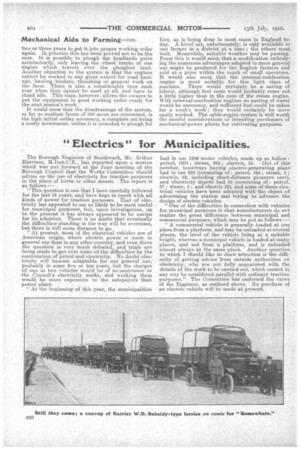Mechanical Aids to Farming.—II.
Page 5

Page 6

If you've noticed an error in this article please click here to report it so we can fix it.
A Series of Four Articles Written with the Object of Assisting the Farmer to Decide upon the Best System to Employ to Meet his Own Particular Requirements. The Second of the Series Deals with the Cable,ploughing System.
By a Contributor.
There are three systems ot mechanical ploughing employed by English farmers to-day, the best known, perhaps, being the double-engine or cable system which was introduced somewhere about 1849. In the early cable-tackles only-one steam engine, of the portable type, was employed, with windlass anchors and rope porters. These anchors, porters, and the engine -were drawn into the fields and placed in position by horses. Much time was lost in fixing them up, and making preparations before the actual 'sloughing operations could be commenced. In order to eliminate this waste self-moving anchors and windlasses were introduced, and a, considerable amount of time and money was spent in endeavouring to perfect them. They were manufactured by J. and F. Howard and Sons, Bedford, Barford and Perkins, Ltd., Peterborough, and J. Fowler and Co. (Leeds), Ltd. Several sets were sold in England, and some of them are being operated to this day OD large estates. Engineers and farmers soon realized that the singleengine system, employing a portable engine, could be worked to advantage. In 1850 J. Fowler and Co., Ltd., introduced what is known as the double-engine system, for which its name is famous amongst agriculturists in every part of the world. Other manufacturers followed, namely, Aveling and Porter, Ltd., Chas. Burrell and Sons,Ltd.' Ransomes, Sims and Jefferies, Ltd., and J. and H. McLaren. In England to-day some 400 to 500 of these sets of tackle are at work, and it is estimated that over 20,000 sets are working in all parts of the wend, some of which are more than 40 years old.
Capabilities of Double-engine Cable Sets.
Many farmers know the capabilities of this system, but perhaps a few statements showing the amount of work of which these machines are capable would interest readers of THE COMMERCIAL MOTOR.. A set of 14 h.p. nominal ploughing engines can plough with a six-furrow plough 20 to 25 acres per day, and it is capable of -cultivating 50 to 55 acres per day. During a season it is estimated that the ploughing and cultivating accomplished by one set will amount to 3000 or 4000 acres. Owners of these tackles usually let them out on contract at 10s. to 12s. per acre, the farmer finding coal and water. During the last year, owing to the extra cost of labour and material, the price has been suniewhat higher than the figures given. It will be seen that 120 to 150 acres of land can be ploughed per week, and about 300 acres can be cultivated per week. These totals are, if anything, on the low side.
Labour Required.
To work the double-engine system four men and one boy are required, and one mansand a horse for carting fuel and water, whichthe fanner has to find as part of his contract. The engines should be placed about 400 yds. apart (if fields will permit). They can be worked at a less distance, but less efficiently owing to the need for more frequently reversing the implements. If these machines are properly worked the very best class of ploughing can be performed. Every farmer knows the importance of good ploughing. The difference between good and bad work is often the difference between success and failure of the resultant crops, and from years of experience it has been proved that it is possible to make perfect seed beds by the employment of this system. Most
operators are paid a bonus on acreage ; consequently the work is sometimes not done in the most satisfactory way. The farmer should insist on good ploughing, even though he may have to pay a little more per acre. • The Cable System Good for a Variety of Work.
With the cable system pleughing can be performed to practically any required depth. It is well known that after land has been under cultivation for several years it is advisable to plough it to a greater depth than usual in order to loosen theasubsoil and allow any excess of moisture to drain away. This process also allows greater freedom for the roots of growing crops, with a resulting improvement in their value. In respect of variety of work, too, the cable system excels ; for deep cultivation, mole draining, working on the sides of hills and on hilly ground, it is unequalled. Cross-ploughing can be performed easily. In fact, if the correct types of implements b„e employed, all operations for preparing seed beds can, be done bY these sets of tackle. One very important advantage of the system is that the land is not consolidated as the engines only travel along the headlands and not up and down the field as in the. .ease of the direct ploughing system, of Which snore will be said later. Further, only a very small headland need to left unploughed. There is another advantage which has a, very important bearing on tIv. efficiency and economy of this system ; all the engine power is employed to pull the implements by means of the steel cable from one side of the field to the opposite side, alternatively ; none is utilized, -while operating, to transport the engine. The cables are capable of ploughing 6000 to 8000 acres before being replaced by new ones. It will be seen that only one engine is at. work when the implement is being hauled, allowing time for the driver of the other to• keep steam up and stoke, lubricate the working parts, and keep the machine generally in proper worIiiig order.
There are three types of ploughing engines ma,nnfactured in England-at present, i.e., those fitted with side drums, those with horizontal drums, and the internal-combustion-engined machines manufactured by Walsh and Clark, Ltd. It is claimed for the verticaldrum type that all intermediate gearing between the crankshaft and the coi1ir drum is avoided, that no coiling gear is neeessarY, and that in consequence less wear an the ropes takes place, but it has been proved
in practice that ow b
owing to the had coiling of the ropes they wear mach more quicklY than when used an the horizontal type of drum.
The modern pia-sae-dug engine can be fitted with two ploughing speeds (at an extra ,,cost). This is a great advantage where beavy and light land has to be plbughed ; the low 'speed can be employed on the heavy work and hilly land, and the fast speed on light work and level land. The result is more work performed with less wear and tear of equipment. Superheaters are also being•fitted by some makers. These will effect great savings both in fuel and, water, matters for serious consideration when labour and coal 'axe rising in price.
Objections and Disadvantages.
The objections raised by farmers who have had no experience in this class of ploughing .tackle seem to be that the heavy weight of the engines would consolidate the land to such an extent that it would take two or throe years to get it into proper working order again. In practice this has been proved not to be the case. It is possible to plough the headlands quite satisfactorily, only leaving the wheel tracks of one engine which travels over the ploughed land. Another objection to the system is that the engines cannot be worked to any great extent for road haulage, hauling binders, thrashing or general work on the farm. There is also a considerable time each year when they cannot be used at all, and have to stand idle. This time, however, allows the owners to put the equipment in good working order ready, for the next season's work.
• It would seem that the disadvantage of the system, so far as medium farms of 300 acres are concerned, is the high initial outlay necessary, a complete set being a costly investment, unless it is intended to plough for hire, as is being done in most cases in England today. A hired set, unfortunately, is only available to one farmer in a district at a time ; the others must wait. Meanwhile, suitable weather may be passing. From this it would seem that a modification embodying the numerous advantages adapted to more general use might be produced for the English farmers and sold at a price within the reach of small. operators. It would also seem that the internal-combustion engine is most suitable for this light class of machine. There would certainly be a saving of labour, although fuel costs would probably come out a little higher than in the case of the steam engine. With internal-combustion engines no carting of water' would be necessary, and sufficient fuel could be taken for a week's work ; they would certainly be more easily worked. The cable-engine system is well worth the careful considerations or intending purchasers of mechanical-power plants for cultivating purposes.
























